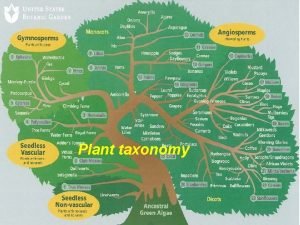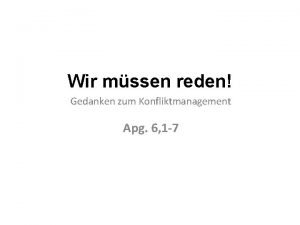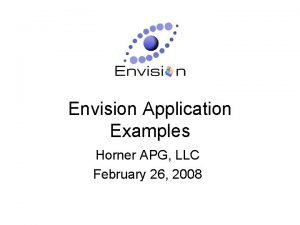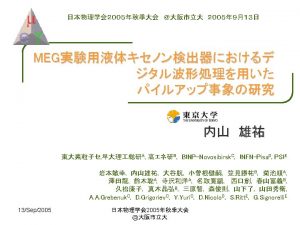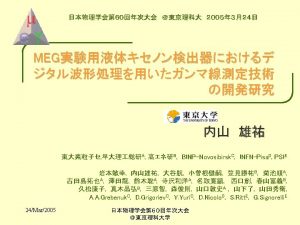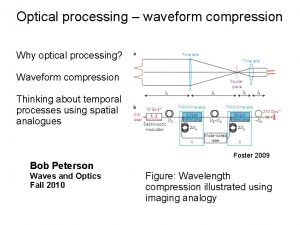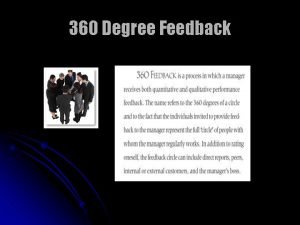Senility Degree Our machine derives APG waveform after











- Slides: 11

Senility Degree Our machine derives APG waveform after 2 nd differential of arterial pulse wave in order to measure… 1. Cardiac Eccentric Constriction Power 2. Arterial Elasticity 3. Remaining blood volume in the Vessel 4. Aging Degree of the Blood Vessel Plethysmogram (PTG) Velocity Plethysmogram (VPG) Acceleration Plethysmogram (APG) 1

Waveforms of APG • • a : The base value to compare easily at the wave observation b:Strength of cardiac output - The deeper(-), it means that the blood vessel is in good shape. c : Vascular elasticity - It means the vascular elasticity, and the higher (+)value is better from the middle line. d: Remaining blood volume - The better the blood vessel is, the remaining blood volume is low and it shows in (-)value. * The gradient of b, d point : understand the vascular state and aging processing Cardiac-output intensity Peripheral vascular elasticity Remained blood volume analysis Seize vascular state Blood circulation Dysfunction Arteriosclerosis Blood aging 2

APG Part 2. APG Theory APG – The Change Map According to The Age b/a (Cardiac Output) : As it has (-)value, the older in age, and the lower in value. c/a (Elasticity) : As it has (+)value, the older in age, and the lower in value. d/a (Remaining Blood Volume) : As it has (-)value, the older in age, and the lower in value. 3

Levels of Blood Circulation Classifying the wave type as aging Blood circulation and its vessel are good 7 steps By the vascular state Current blood circulation and its vessel are good, but may go bad Start to get aged in the vessel Not good at the blood circulation and getting aged in the vessel Blood circulation disorder 4

Reading Guide 1 st Step : Pulse wave Analysis Result It displays the wave pattern at this step and analyzes the aging process of arteries at 2 nd step and 3 rd step. 1) Pulse Wave (Basic Pulse Wave) : It describes the pulse wave of the patient. 2) Accelerated Pulse Wave (Analysis Pulse Wave) : It describes the accelerated pulse wave pattern that did the second differentiation on the basic waves. 5

Reading Guide 2 nd Step : Vascular State Analysis 1) Wave Type : Based on between b/a and d/a slopes, it classifies from the Type 1 to Type 7. While it goes to the aging level, it means that there may be problems in the vascular circulation. 2) Level Analysis : It describes the distribution for each step. It also displays the wave type of all pulse wave patterns during the measurement. Although the same wave types are existent, it may be different on the distribution map, and if there are many subordinate wave types, it means the vascular circulation may go bad. 6

Reading Guide 3 rd Step : Analysis Result of the Age It describes the result of values by calculating the basic points of accelerated pulse waves. Sub-optimal / Normal / Optimal (Good condition based on Normal and Optimal) 1) DPI (Differential Pulse wave Index) : Main indicator that represents the aging degree of arteries. => -b + c + d / a It means if (-) value is lower, the vascular aging degree is going bad. 1) EC (Eccentric Constriction) – It analyzes the b/a value out of basic waves. : If the cardiac output is higher, the vascular state is good and the result value should be bigger in (-) value. 7

Reading Guide 3 rd Step : Analysis Result of the Age 3) AE (Arterial Elasticity) – It analyzes the c/a value out of the basic waves. : It means the elasticity of arteries and if the elasticity is bad, its value moves from (+) value to (-) value. 4) RBV ( Remaining Blood Volume) – It analyzes the d/a value out of the basic waves. : If the vascular state is better, the remaining blood volume will be lower and it describes with (-) value. But, if the aging degree is in progress, EC will be weaken and RBV will be remained high. It is an important indication of classifying the wave type. 5) HR (Heart Rate) : Mean Heart Rate, normal range is 60~90. 8

Reading Guide 1 2 4 8 3 5 6 9 10 7 11 10

Reading Guide 1 HRV Tachogram 2 Mean Heart Rate : The normal range of adults is between 60~90 per minute. Artifact Heart Rate : It means the rhythms deviated from the normal range and also it may be It shows the changes of heart rate for 3 or 5 minutes and more complicated and wider waveforms of heart beats indicate much healthier. The red lines in the middle shows the standard deviation and healthier person has much wider. appeared when the person moves during the test or he or she has an arrhythmia. If it shows over 5 times, should be tested again. 3 4 5 TP : It combines VLF, LF and HF and if it is located in “I” bar or over the bar, it means that the autonomic nervous system functions well but if it is under the bar, it means the autonomic nervous system functions badly and the stress resistance ability is also weak. VLF : It doesn’t mean too much in diagnosis at 3 minute test mode, but it may be appeared to those who have too much changes in hormone or inconsistent characters. LF : It shows the activity of sympathetic nerve and parasympathetic nerve at the same time, but it mostly indicates the sympathetic nerve system. If it is located under the normal range, it means that he or she has lethargy, sluggishness or sleep disorder. HF : It shows parasympathetic nerve system and if it goes under the bar, it causes a lack of stability in heart function, chronic stress, functional dyspepsia, and senility. It indicates the balance between sympathetic nerve and parasympathetic. And its normal rate is 6: 4, 5: 5 or 4: 6. If SNS is too much higher, it is highly nervous state. If PNS is too much higher, it means the depression, lethargy, or lack of will. Power Spectral Density : It indicates the distribution graphs of each VLF, LF and HF. 11

Reading Guide 6 7 8 9 10 11 Physical Stress : It shows the stress level in physical state. Mental Stress : It shows the stress level in mental state. Stress Resistance : It means the ability that sustains the stability of control against the stress. Score of Your Stress : By analyzing all indexes of stress, it displays in score and 100 score means heavy stress state currently and lower score means more healthier. Aging Vascular Health : It is classified for the aging process of vessel from type 1 to type 7 and displays the vascular state of each type in percent(%). Type 1 shows the best vascular state and when the senility is under progress, it makes higher types. When it is over type 5, this person may have arteriosclerosis. DPI ( Differential Pulse wave Index) : It represents the overall health of the senility. EC (Eccentric Constriction) : It means the cardiac output power. (The bigger the value is, the better the health is) AE (Arterial Elasticity) : It means the arterial elasticity. (The bigger the value is, the better the health is) RBV (Remaining Blood Volume ) : It means the remaining blood volume after cardiac constriction. (The smaller the value is, the better the health is) All parameters mean the normal as a good state and the optimal is much better. Wave Type : It displays the representative type that has more percentages out of all types. Type 1 – As the best type, it has the best blood circulation and good elasticity. Over Type 5 – It gets more aged in the vessel and may have arteriosclerosis, high blood pressure or diabetes. COMMENT : It gives the general result of all tests. 12




